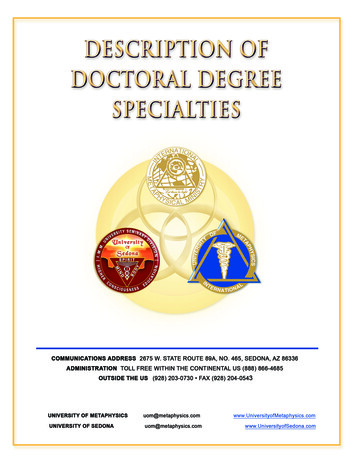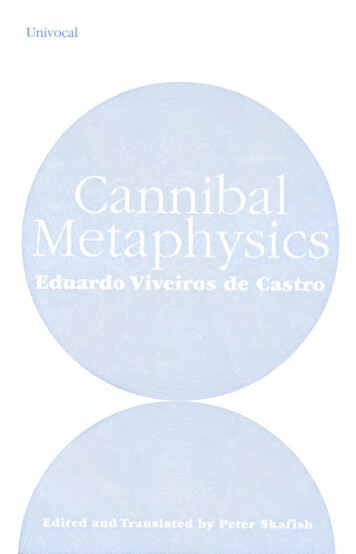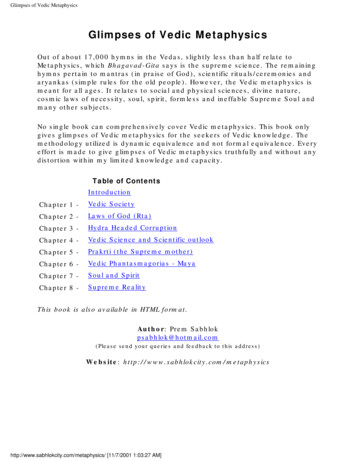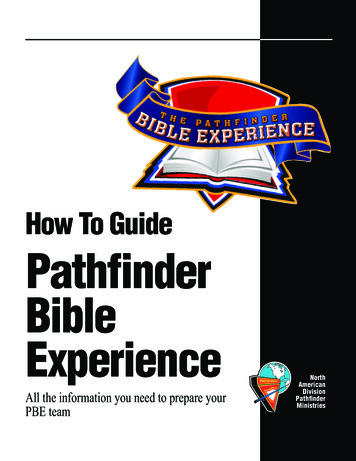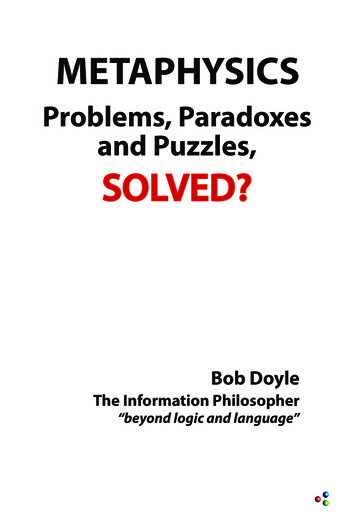
Transcription
METAPHYSICSProblems, Paradoxesand Puzzles,SOLVED?Bob DoyleThe Information Philosopher“beyond logic and language”
This book on the taphysics
METAPHYSICSProblems, Paradoxesand Puzzles,SOLVED?Bob DoyleThe Information Philosopher“beyond logic and language”
First edition, 2016 2016, Bob Doyle, The Information PhilosopherAll rights reserved. No part of this book may be reproduced inany form by electronic or mechanical means (including photocopying, recording, or information storage and retrieval) withoutthe prior permission of The Information Philosopher.Publisher’s Cataloging-In-Publication Data(Prepared by The Donohue Group, Inc.)Names: Doyle, Bob, 1936Title: Metaphysics : problems, paradoxes, and puzzles, solved? /Bob Doyle, the Information Philosopher.Other Titles: Metaphysics : problems, paradoxes, puzzlesDescription: First edition. Cambridge, MA, USA : I-Phi Press,2016. Includes bibliographical references and index.Identifiers: ISBN 978-0-9835802-6-3 ISBN 978-0-9835802-2-5(ebook)Subjects: LCSH: Metaphysics.Classification: LCC BD111 .D69 2016 (print) LCC BD111(ebook) DDC 110--dc23I-Phi Press77 Huron AvenueCambridge, MA, USA
DedicationTo all the metaphysicians on the Metaphysicist.com website.Special thanks to many who have sent suggestions andcorrections to ensure that their work is presented as accuratelyas possible for the students and young professionals who use theMetaphysicist and Information Philosopher websites as anentry point into some great intellectual problems that they mayhelp to clarify and teach to others in the coming decades.Information is like love. Giving it to others does not reduceit. It is not a scarce economic good. Sharing it increases the totalinformation in human minds.Information wants to be free.Bob DoyleCambridge, MADecember, 2016
viMetaphysicsstnetCon
ContentsContentsPrefaceHow To Use This Book With The Metaphysicist Website1. IntroductionHow We Proceedxi13112. Abstract EntitiesInformation as a Physical CauseColors as Abstract Entities 1816; The Idea of Abstraction3. Being and BecomingBeing and Becoming in Modern Physics4. CausalityThe Discovery of Ontological Chance6. ChangeCosmic Change as the Growth of Information StructuresAn Information Analysis of “Coinciding Objects”8. Composition35Is Constitution Identity?10. Essentialism555969;75Intrinsic Information as EssenceEssentialism 8011. Free WillThe Two-Stage Model of Free WillThreaten Free Will? 9212. God and Immortality79; Natural Kinds and Mereological85; Does Ontological ChanceNo Creator, But There Was/Is A CreationThe Problem of Immortality 9813. Identity4750Temporal Parts 66; Mereology 67; Mereological EssentialismBiomereological Essentialism 72; Composition as Holism andEmergence 739. Constitution2530;437. Coinciding Objects132122What Counts as a Cause? 26; The Problem of InductionInduction and the Scientific Method 315. Chance17;96; The Ergod97;6375798395101Information Identity 101; A Criterion for Identity 101; A Criterionfor Essence 103; Background of the Problem 104; Leibniz 107; Leibniz’s Laws 108; Frege 109; Peirce 111; Principia Mathematica 112;Wittgenstein 113; Frank Ramsey on Identity 114; Willard Van OrmanQuine on Identity 115; Ruth Barcan Marcus 120; David Wiggins 121;Saul Kripke on Identity 122; Peter Geach on Relative Identity 125;vii
viiiMetaphysicsDavid Lewis 126; Relative Identity 126; A A 129;Identity through Time 130; Changes in Time 131;Personal Identity 132; Identity and Biology 132; Vague Identity14. IndividuationThe History of Individuation 135; The Biology of IndividuationIndividuation and Quantum Mechanics 140133135139;15. Mind-Body Problem14316. Modality15117. Necessity (or Contingency)161The Problem of Mental Causation 144; Mind as an Experience Recorderand Reproducer 146; Consciousness a Property of Mind 149Actual Possibles and Possible Possibles 155; The Many Possible Worlds inOur Actual World 156; Necessity of Identity and the Limits ofNecessitism 157; Modal Realism and Possible Worlds 159The Logical Necessity of the Analytic and the A Priori 161; The Logical Necessity of Necessity 162; The Necessity of Identity 165; SeparatingNecessity from Analyticity and A Prioricity 167; Necessity andFree Will 170; No Logical Necessity in the Material World 172;Necessitism 17318. PersistencePerdurance177; Endurance19. Possibility179; Temporal Parts?179175181Actual Possibles 183; Actualism 184; Possibilities in Quantum Mechanics 185; Shannon and Quantum Indeterminism 186; An InformationInterpretation of Quantum Mechanics 189; Possible Worlds 190;Other Possible Worlds 19320. Space and Time195Space and Time in Quantum Physics 196; Nonlocality and Entanglement 200; Visualizing Entanglement 201; Can Metaphysics Solve theEPR Paradox? 20321. UniversalsThe One and the Many22.Vagueness207211Vagueness and the Two-Slit Experiment23. Wave-Particle Duality213215The Heart of the Puzzle 218; The History of Waves and ParticlesDueling Wave and Particle Theories 222;Dirac on Wave-Particle Duality 22524. The Debtor’s ParadoxInformation Philosophy Resolves the Debtor’s Paradox229217221;227
Contents25. Dion and Theon233What Chrysippus May Have Been Doing 234;An Information Philosophy Analysis 23726. Frege’s PuzzleNames and Reference 243; Quine’s ParadoxesThe New Theory of Reference 246244;27. The Growing Argument28. The Infinite Regress29. Porphyry’s Fateful Question30. The Problem of the ManyPeter Unger261; Peter Geach31. The Ship of Theseus32. Sorites PuzzleLiar Paradox27133. The Statue and the ClayHow to Make Two Out of One34. Tibbles, the Cat35. Metaphysicians249253257259262How Information Philosophy Resolves the ParadoxHow to Make Two Ships Out of One. 266275241265;265269273279285David M. Armstrong 285; Michael Burke 287; Rudolf Carnap 292;David Chalmers 293; Roderick Chisholm 296; René Descartes 298;Peter Geach 300; David Hume 302; Immanuel Kant 304; SaulKripke 305; David Lewis 315; E. Jonathan Lowe 316; Ruth BarcanMarcus 318; Trenton Merricks 319; Huw Price 323; Willard VanOrman Quine 325; Michael Rea 330; Alan Sidelle 332; Ted Sider 335;Peter Unger 339; Peter van Inwagen 340; Timothy Williamson 34936. A History of Metaphysics353Great Problems Solved?BibliographyIndex387397404The Presocratics 353; Socrates and Plato 354; Aristotle 354; The Stoics 356; Academic Skeptics 360; The Scholastics 360; Descartes 361;Leibniz 361; The Empiricists 364; Kant 365; Positivisms 366;Linguistic Analysis 369; Modal Logic 370; The Necessity of Identity 374;David Wiggins on Identity 375; Saul Kripke on Identity 377; DavidLewis on Identity 378; Modal Logic and Possible Worlds 379;Why Modal Logic Is Not Metaphysics 381; The Return of Metaphysicsand Its Paradoxes 384ix
xMetaphysicsPrefaceecafePr
PrefaceMetaphysics has been rejuvenated in the past few decades, afternearly a century of attacks from logical positivists, logical empiricists, behaviorists, and eliminative materialists, with their loudcries that metaphysics is “meaningless” or “non-sense.”Traditional metaphysicians asked questions about the fundamental nature of physical reality. Modern metaphysicians claim tobe looking into the foundations of metaphysics, sometimes calledmeta-metaphysics. Similarly, they are looking for a new basis forontology, a meta-ontology.They are also engaged in a critical review of why attacks onmetaphysics were so successful in the past century. Some seemany years of what can be looked at today as just verbal quibbling,what Kant once called “word-juggling “ (Wortklauberei). Can theanalysis of language, of concepts and their precise definitions,yield truths about the world? Many famous debates now appearto have been metaphysicians talking past each other, captivatedby their elaborate conceptual schemes and dense jargon. Othersthink metaphysics might have had a more scientific approach.Although few moderns draw much of metaphysical importancefrom today’s sciences of physics, chemistry, biology, or psychology, for example, some do like a methodology of hypotheticalaxiomatic systems that may even offer the kind of experimentaltesting that is the watchword of modern science.Some view the “naturalization” of epistemology by WillardVan Orman Quine as a step toward a more scientific metaphysics, but others criticize the limited “extensional” approach ofQuine and Rudolf Carnap, in which meaning and truth of ourwords are to be found in the members of sets of objects.Other “intensionalists” find meaning located in human intentions, either in initial speech acts or final interpretations of meanings in relevant contexts, but both of these are vulnerable tocharges of relativism from modern skeptics. Proponents look tophilosophers of science who are impressed by interpretations ofxiPrefacePreface
xiiMetaphysicsPrefaceFigure iv-1. A taxonomy of metaphysical problems, puzzles, and paradoxes.
quantum physics that may indicate that reality is not an external,observer-independent entity.Perhaps the most significant development in the rebirth ofmetaphysics has been the reintroduction of modal thinking thathad been a vital part since Aristotle, but was more or less forgottensince the late-nineteenth century creation of second-order propositional logic by Gottlob Frege.Quine opposed the reintroduction of modality, but parallel tothe existential and universal quantifiers he thought sufficed, modallogicians have added operators for possibility and necessity. Nextto , “there exists” or “for some,” and , “for all,” modal logicianshave added operators for “possibly” and “necessarily.”Necessity is defined as propositions true in all possible worlds.Possibility is defined as propositions true in some possible worlds.But there is no room in the new modal logic and its manypossible worlds for contingent statements, about the future forexample, propositions that are not yet either true or false.The possible worlds of David Lewis are in fact as eliminativelymaterialist and completely deterministic as the most classicalphysics. There are no possibilities in Lewis’s possible worlds.Leading metaphysicians who see the new modal logicas metaphysics have an opportunity to make a significantbreakthrough in visualizing the fundamental nature of physicalreality, if they can get beyond claims they have found an absolutemetaphysical necessity - the necessity of identity, for example.We will examine their arguments for the necessity of identityand offer a criterion for identity, one that establishes the existenceof relative identity, as well as finding an absolute identity, which wefind must be limited to cases of self-identity.And we will make the case for the existence of metaphysicalpossibilities, which may allow metaphysics to become the groundfor the so-called “quantum reality” of modern physics.Without metaphysical possibility there can be no foundation forthe possibility of metaphysics.PrefacePreface xiii
xivMetaphysicsPrefaceIn part 1, chapters 1 to 23, we examine some classic problemsin metaphysics, attempting to resolve them by analyzing theirinformation content, not their logic or language.Chapters 24 to 34, in part 2, look at some of the most ancientpuzzles and paradoxes of metaphysics, still unsolved but nowrejuvenated. We also look at a few modern puzzles.These chapters are arranged alphabetically. They can beassigned for independent reading. As a result, there is considerableredundancy on some basic concepts.Since this work is intended as a critical resource for students, weprovide extensive quotations from original thinkers to avoid clumsyparaphrases in our words of their unique ideas.In part 3 (chapter 35) we describe the works of some leadingmetaphysicians.In part 4 (chapter 36)we briefly review the history of metaphysics.In an appendix, we summarize a number of other problems inphilosophy, physics, cosmology, psychology, and biology for whichan information philosophy approach suggests plausible solutions.Most of our chapters are supplemented by additional material onthe web pages at www.metaphysicist.com.Bob s.harvard.eduAstronomy DepartmentHarvard UniversityCambridge, MADecember, 2016
1How To Use This Book With The Metaphysicist WebsiteThe content of this book comes from our new metaphysicist.comwebsite and the informationphilosopher.com website. You willfind multiple entry points into the websites from this book, withURLs for the chapters and in many of the footnotes. I hope thatyou agree that the combination of a printed book and an onlineknowledge-base website is a powerful way to do philosophy in thetwenty-first century.The Metaphysicist site has four drop-down menus - Problems,Puzzles, History, and Metaphysicians. Above these are the eightdrop-down menus of the parent Information Philosopher website.Figures in the text often are full-color animated images on theI-Phi website. All our images come from open-source websites.Names in Small Caps in the book are the hundreds ofphilosophers and scientists with their own web pages on the I-Phiwebsite. Active links on the Metaphysicist site will jump to thosethinkers on I-Phi.
2MetaphysicsChapter 1Chapter 1noitcudortIn
Introduction3We apply methods of information philosophy to metaphysicsand find solutions to several classic problems, puzzles and paradoxes. You can find them all on our website metaphysicist.com.The most important of these are the problem of absolute andrelative identity, the problem of composition (parts/wholes) andof coinciding objects, Aristotelian essentialism, the need for ametaphysical possibility, and the semantics and modal logic of“possible worlds.”Many ancient puzzles are variations on the problem ofcoinciding objects, including Dion and Theon, the Growing Argument, and the Statue and the Clay. We solve these puzzles.A central problem in information philosophy is the existentialor ontological status of ideas. We show that while ideas exi
11.11.2016 · Metaphysics has been rejuvenated in the past few decades, after nearly a century of attacks from logical positivists, logical empiri-cists, behaviorists, and
